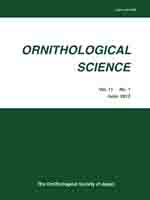Foraging behavior and diet of Streaked Shearwaters Calonectris leucomelas rearing chicks on Mikura Island was studied using depth and temperature recording data-loggers and stomach contents. Water mass where birds were foraging was estimated using sea surface temperature experienced by birds. Birds spent 76–96% of their time at sea flying, 4–24% for landing on the water, and made a few (0.5–17.0 per day) shallow (<6 m) dives. Birds made many short (<2 days) and some long (4–10 days) trips. During short trips, birds stayed in the warmer Kuroshio and Kuroshio-Oyashio mixed regions, and fed on Japanese Anchovy Engraulis japonicus, Common Squid Todarodes pacificus and Flying Fish Cypselurus hiraii. During long trips, birds stayed in the colder Oyashio region and fed on anchovy and Pacific Saury Cololabis saira. Birds made more dives during short trips than they did during long trips. Streaked Shearwaters breeding on the island in low—productive Kuroshio water, therefore, adopted dual foraging strategies, and changed their diet and dive frequencies in relation to water masses.
How to translate text using browser tools
1 June 2012
Foraging behavior and Diet of Streaked Shearwaters Calonectris leucomelas Rearing Chicks on Mikura Island
Kei Matsumoto,
Nariko Oka,
Daisuke Ochi,
Fumihito Muto,
Takashi P. Satoh,
Yutaka Watanuki
ACCESS THE FULL ARTICLE

Ornithological Science
Vol. 11 • No. 1
June 2012
Vol. 11 • No. 1
June 2012
anchovy
data-logger
Dual foraging
Oyashio




